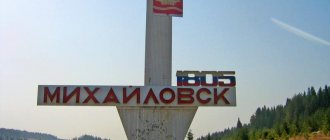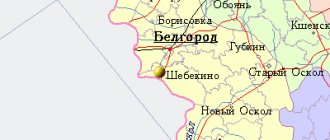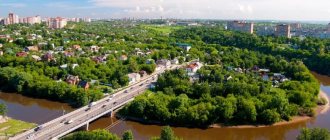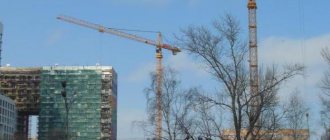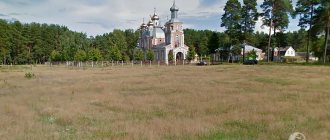In the direction to the north, the city territory borders on the districts of Moscow, and in the direction to the east, south and west - on the lands of the Podolsk region.
The city of Shcherbinka is located in the Moscow region of the Russian Federation. The territory of the city is characterized by a flat, slightly hilly terrain. The eastern part of the city (southern industrial zone and comfortable multi-storey residential buildings) is tied to the most elevated parts of the relief, the western part of the city - to the lower parts of the relief. The height difference in the territory does not exceed 20-40 m per 1 km. The average annual precipitation in the form of rain and snow is 710 mm, and the maximum precipitation occurs in the months of July and September-October, reaching a value of 130-150 mm. The location of the city of Shcherbinka, like the entire Moscow region, is characterized by moderate climatic conditions. The nearest monitoring points for climatic, meteorological conditions and background air pollution of Roskomhydromet bodies are located in Moscow (Lenino-Dachnoe village) at a distance of four km, in the direction of the north, and in Podolsk at a distance of 16 km, in the direction of the south.
City `s history
The genealogy of Shcherbinka takes us back to the beginning of the last century... Popular rumors and testimonies of old-timers introduce us to such a legend... At the very beginning of the 19th century, on the site of the present Shcherbinka, the Lipka tract and the Militia village, lay the rich estate of the landowner Shcherbinka.
This landowner founded a village for his serfs, which then consisted of seven courtyards. That’s what they called the serfs: “Whose are you, men?” - Yes, you see. We are Shcherbinka... And later the whole village began to be called: Shcherbinka. In 1812, during Napoleon’s invasion of Moscow, Shcherba fled from his estate, burying all his valuables somewhere near the ponds. After Bonaparte was expelled, Shcherba did not return to his family estate; since then it has been resold from hand to hand. At the very beginning of the sixties, the estate passed to N.O. Sushkin, who retained his estate until the revolution. Sushkin was a wealthy moneylender, had estates in other regions, and he used the Shcherbinskoye property as a productive subsidiary farm. He did not live permanently in Shcherbinka, spending only the summer months there, as at a dacha near Moscow. Nevertheless, under his rule the farm became profitable and comfortable. In 1861, the peasants of Shcherbinka received plots of land at the rate of one dessiatine per capita, and a total of 85 dessiatines. It was these peasant tithes that formed the basis of the lands of present-day Shcherbinka. The master's part of the estate was remodeled. The residential center was moved from the Serpukhovskaya road deep into the site, behind a pond, where two residential buildings with services, five dachas were built, a cultural park was laid out on an area of one hectare, a pond was cleared, a swimming pool and a bathhouse were built, and closer to the forest a large an orchard, which later brought considerable income to the owner. The entrance to the estate was formally decorated: wide iron gates led to the poplar alley to the manor house, and above the gate there was an inscription: “Welcome.” There was a new feature at the gate, a sundial, everything was designed for large receptions of frequent guests. The dachas were rented out for the summer to Moscow summer residents, among whom the French were regulars. Before the revolution itself, the estate had one hundred dessiatines of arable land, two hundred dessiatines of forest land, and, in addition to small livestock and poultry, there was a herd of sixty heads of cattle and twenty heads of horse park. In the seventies, a railway was built from Moscow to Kursk, but at first there was no stopping point in the area of the village of Shcherbinka, there was only one track barracks for the track workers. When a landowner was passing from Moscow, at his request, the train was stopped at this barracks. But already in 1890, Sushkin obtained from the owners of the road the establishment of a permanent stopping point called “Platform Shcherbinka”, named after the village located a mile from the road. The establishment of the platform was also helped by the simultaneous efforts of Baskakov, whose woolen factory was already operating on the Desna River, three miles from the railway. A station appeared, but it was separated from the estate by peasant fields, and Sushkin bought from the peasants a strip of land from the estate to the platform and built a highway on it in the European style, decorating it along the edge by planting trees and shrubs, installing garden benches for relaxation (now on its remains lie on the street 40 Let Oktyabrya). But the constructed road was for the individual use of the owner and his guests, to ensure this, lockable barriers were placed at the beginning and end of the road. In 1912, the peasant community turned to Sushkin with a request to transfer this road, which was very necessary for the peasants, to the zemstvo, but the principled owner, fearing that manure from the peasants’ Savraskas would spoil the appearance of the lord’s road, refused the transfer, installing another intermediate barrier in response. From the south, the estate bordered on the lands of the church in the village of Zakharyino, which were located to the west of the railway, filling all the space between the railway and the highway. According to stories, this village was named in honor of a certain ataman Zakharka, who back in the 17th century stood with an army in these places, defending Moscow from Tatar raids, and a horde of Tatars stood in the village, which still retains the name Ordyntsy. Zakharyino was a large village that had a parish school in the 19th century, and around, along with church lands, lay landowners' estates, and according to one version, the village allegedly received its name after one of the owners, landowner Zakharov. It was on the Zakharyinsky lands, on rich red clays, that an enterprising merchant established a handicraft brick production at the end of the 19th century. She bought the factory in Shcherbinka for the construction of her enterprise in Podolsk in 1900. After the completion of the construction of Singer, the Shcherbinsky brick factory was sold again and soon passed into the possession of a small entrepreneur V.V. Belousov, who somewhat expanded production by updating the equipment, although in general the enterprise continued to remain semi-handicraft. Nearby there were barracks for workers and a small one-story house, in which Belousov’s apartment was in one half, and the enterprise’s office in the other. From the platform to the right a road led to the ancient villages of Nikolskoye and Ostafyevo, and further to the Baskakov cloth factory (now the factory named after May 1). Even further south, to the right of the railway, on a hill, lay the estate of the landowner Druzhinin Baryshi with a park, a pond and a large orchard. And from the brick factory to Podolsk, a significant part of the Zakharyinsky lands was closed from the road by a palisade of white birches and oak trees - an ordinary Russian forest, with its euonymus undergrowth and velvety green edges. The year 1917 came. The small village of Shcherbinka greeted October with only seventeen courtyards, not marked even by large-scale maps of that time. There was the Shcherbinka platform, the only one recognized by official documents as a geographical point, near it there was a barracks, two houses for railway employees. Administratively, this entire territory was subordinate to the newly formed Zakharyinsky village council, in turn, subordinate to the Sukhanovsky volost executive committee of the Podolsk district. The pioneers in settling the future village were railroad workers. They were the first to request the allocation of land plots from the nationalized church plots of the Zakharya parish. They were presented with a plot of Popovaya Grove, with the condition of cutting down and uprooting this forest plot and handing over the timber for state needs. Opposite the station building, along the future Zheleznodorozhnaya Street, work began on the construction of a station village. In 1918, Belousov’s son’s enterprise was nationalized, and even later his dacha in Zakharyinsky courtyards was municipalized. After nationalization, the brick factory was transferred to the jurisdiction of Podolsk local industry. An experimental demonstration farm for breeding productive Kholmogory cattle was established on the territory of Druzhinin’s estate. The manor's house, together with a park, a pond and a garden, became the Holiday House of the Executive Committee of the Comintern. In 1918, it was the turn of the nationalization of the property of the heir Sushkin. For this, Chairman Kolokolytsikov came to the Sukhanovsky estate and, as witnesses say, on a hot summer day he met young Sushkin and his wife on the paths of Kolokolytsikov Park, returning from the bath. The chairman and the headman have just finished walking around and inspecting the property. “So, that’s it, Nikolai Nikolaevich,” Kolokolytsikov turned to Sushkin, “come on, brother, distribute the cattle to the peasants yourself.” Let's take away the living creatures... And the gentleman, famous throughout the area for his liberal, almost revolutionary views, did not find anything else to answer: - There's a herd grazing across the road... Take it yourself, if it's yours... He said, throwing a wet towel over his other shoulder and, without saying another word, he walked with his wife towards his house. Two days later, the former landowner couple left the estate forever. In 1920, a state farm was organized on the estate, but at first the farm declined and fell into almost complete decline. The Sushkinsky house burned down, the park with tennis courts and paths sprinkled with yellow sand was destroyed, the sundial also disappeared, and the old pond silted up. Somewhat later, agronomist P.A. was appointed manager of the state farm. Kvitkovsky, who managed to restore the farm, trying to restore it to its former productivity. Even later, the farm was transferred to the First State Stud Farm named after S. Kamenev, and then, in the thirties, it came under the control of the Pervomaisk labor colony of the NKVD Gulag. Time passed. The volleys of the civil war died down, in devastation, in deprivation and poverty, the half-starved country rose to its feet, healing the wounds inflicted by the war, restoring and strengthening the economy and preparing for new great achievements. Then little changed in the area of the Shcherbinka platform. With the consolidation of districts carried out on an all-Union scale, Sukhanov was transferred to the new Ulyanovsk district, and the Zakharyinsky village council with all its lands became directly subordinate to the Podolsk District Executive Committee. The Shcherbinsky heritage of the breeder Belousov has also received an update. In the immediate vicinity of the old plant, in 1928, a new, large, brick plant of the Raipromkombinat began to be built, the first stage of which went into operation in 1928. A large number of seasonal construction workers were involved in the construction of the plant. The forest covering the territory of the future plant was cut down and a workers' town grew up behind the plant, eight barracks and two two-story houses were built. With the launch of the new plant, on its old territory, another regional industrial enterprise was soon organized - the “Glue-Soap” factory. However, the ill-fated “Glue Soap” did not last long, significantly poisoning the surrounding area with harmful waste and stench; it was closed in 1938, and in its place a new enterprise was created - the Shcherbinsky Stamping and Mechanical Plant, which went into operation in February 1938. In 1930, the Experimental Ring of the Central Research Institute of the People's Commissariat for Railways began to be built near the railway platform; the work was completed in 1932. Thus, three main industrial enterprises were created, which became the core around which a workers’ settlement began to form. In 1937, work began on the electrification of the Moscow-Podolsk railway. Railway workers began to settle in Shcherbinka. A large developer appears on the allocated lands. All-Union Trust for the construction of extracurricular bridges NKPS (Mostotrest). Along the Serpukhov highway, a chain of two-story typical bridge workers’ houses appeared called the Mostotrest settlement. Before the fortieth year, two were inhabited, and a third house stood in the forests. At the same time, the railroad built barracks for construction workers on the allocated lands. The alienation of land from the Shcherbinsk agricultural artel was compensated by the transfer to the artel of a land plot of 68 hectares of a subsidiary farm to the Colony named after. May 1st. In 1938, a project for a new residential area was approved for Moscow settlers who were losing living space in Moscow due to the reconstruction of the capital, especially its center. Thus, already at the end of 1938, a significant settlement was actually created, and the question of its name and status arose quite naturally and timely. On December 13, 1938, the settlement of Shcherbinka was renamed a workers' village. In 1939, a planning project for the young village was approved, and that same summer the council began allocating plots for individual construction for immigrants from Moscow. A new district of the village was being laid out. Novomoskovsky. At the same time, the allocation and planning of plots for the construction of individual summer cottages for workers of the 1st State Bearing Plant began, and another area, Shariki, appeared on the map. The application of the Podolsk plant named after Ordzhonikidze for the allocation of land for the plant to build individual houses for the resettlement of plant workers in Shcherbinka was satisfied. So, on the plan of the village next to Mostotrest, the streets of the Ordzhonikidze district grow. The center of the village was determined in the area of the brick factory, since 7,500 people out of the total population of Shcherbinka of 11,200 people already lived there on an area of 606.6 hectares. Priority objects of public importance were planned for construction: a seven-year school, two shops, a fire station, water tanks, wells, bridges, etc. The development of significant areas for housing on the oily Shcherbinsky clay created great difficulties, because even the slightest rain , and even more so during the spring flood, everything around turned into a viscous mess, in which not only transport stopped, but sometimes unpaved streets and passages between barracks became inaccessible to pedestrians. In the Glebov Park (Lipki) tract, the district department of public education is allocated a 4-hectare plot for the construction of the first seven-year school. For railway workers resettled from temporary homes scattered along the Moscow-Kursk railway, 15 hectares have been allocated in Shcherbinka. During the same period, a dead-end access road to the brick factory was built, and the Shcherbinka platform was renamed the Shcherbinka station of the Moscow-Kursk Railway. Plans for peaceful construction were not destined to come true. The black day came on June 22, 1941, the Great Patriotic War broke out. All construction in Shcherbinka has almost completely stopped. In the autumn of 1941, the fascist hordes rushing towards the capital came close to Podolsk. Shcherbinka became a front-line zone; the lines of Moscow’s defensive belt lay across its territory. Shcherbinka was naked and empty. Its population dropped to 6,000 people. Almost half of the male population joined the Red Army. Reserve units of the Red Army were quartered in the liberated and empty dwellings. On December 15, the brick factory stopped and stood until 1943; the stamping plant switched to military needs. A sharp shortage of fuel and the proximity of the front led to the fact that the remnants of the forest on the territory of the village were almost completely cut down, the gardens and parks of the former landowners' estates were damaged, with the exception of the greatly thinned-out Baryshi and Lipki. The borders of the forest area have retreated significantly from the Serpukhov Highway. After the long-awaited victory, the whole country was reborn to a new life; Construction is booming again in Shcherbinka. The central area of the village is being built up, comfortable 3- and 4-story houses are going up, a House of Culture is being built on the square, and the contours of Teatralnaya Street are gradually emerging. The soul of the development of the center and the entire southern part of the village, the financier, was the old brick plant, or rather, at that time already the Refractory Plant. With his investments and concrete assistance, the first cultural stores, medical institutions appear, and general improvement activities are carried out. The same role, initiatives and funding in the northern part of the village belongs to the Central Research Institute of Ministry of Railways. Simultaneously with the development of its production base (ring). The Institute is constructing permanent 3- and 4-story residential buildings, taking on the construction of other public facilities and communications. He also has the honor of being the pioneer of the development of microdistrict No. 2, a large wasteland between the Central (Kirpichny) and Northern (Lublinsky) districts, used by the population as a potato field. In 1950, the Head Repair and Restoration Train No. 1 of the Ministry of Railways (GOREM-1), a construction organization for railway workers, arrived in Shcherbinka. In the Lublin microdistrict, 17 two-story eight-apartment houses, six two-story wooden houses, then three four-story houses and even one five-story house were built in a short period of time. An artesian well, a water tower, a large boiler room were laid for the city, water supply, sewerage, and steam pipelines were laid. The Moscow-Kursk, and now the Moscow, railway made a significant contribution to the development of the village. The railway workers, after completing the construction of their initial eight-apartment buildings on two floors, moved on to the construction of four-story houses, built their own boiler house, and provided residential buildings with water, sewerage and heat. In 1950, a town for the Moscow police began to be built on farm lands: first wooden buildings appeared, and later permanent buildings began to be erected. In 1955, another significant enterprise grew on the desert lands allocated to Geological and Petroleum Exploration. Moscow experimental elevator-building plant of the Soyuzlift trust of the Ministry of Construction, Road and Municipal Engineering. Shcherbinka began to grow and improve intensively in 1957. Roads and central streets were dressed in asphalt, street lamps, sewers, and street drains appeared. In 1961, an automatic telephone exchange was built, and the residents of the village began to have telephones. The scourge of Shcherbinka, its impassable mud, is gradually becoming a thing of the past. In 1962, GOREM-1 erected the first 5-story panel residential building on Sadovaya Street.
Coat of arms of Shcherbinka district
The coat of arms of the Shcherbinki settlement is a Moscow-shaped shield. In the blue field of the coat of arms, edged in gold, from the center to the periphery there are the following stylized images: a section of a railway rail in a ring - silver, white, a bowl of a glass furnace - gold, yellow with silver, white rustication, a silver gear, as well as golden sun rays , between which light blue rays pass.
The items depicted on the coat of arms of the Shcherbinka settlement symbolize important city-forming enterprises. The cut end of the railway rail inside the ring is a symbol of the VNIIZhT Experimental Ring.
The bowl of the glass furnace indicates the Shcherbinsk plant of electrofused refractories and the Podolskogneupor enterprise, which operate in Shcherbinka. The brickwork represents large-scale construction in the city. The image of the gear is reminiscent of the Shcherbinsky Elevator Plant. The blue background symbolizes the sky and the airport of the Ostafyevo garrison, which is also located on the territory of the settlement. The rays of the rising sun are a symbol of the founding of Shcherbinka and the youth of the settlement.

